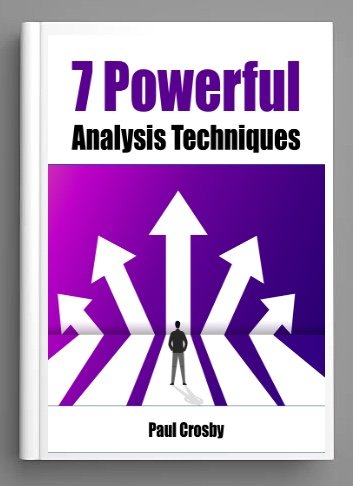Enhancing the Requirements Work Plan (RWP) with CATWOE: A Strategic Blueprint for Success
In the realm of project management, the foundation of achieving exceptional outcomes lies in the meticulous planning and analysis of requirements. Business Analysts (BAs) are at the helm of this critical endeavor, employing a variety of business analysis techniques to ensure that project requirements are comprehensive, clear, and aligned with the overarching goals. Among the plethora of tools at their disposal, the CATWOE technique stands out as a particularly effective method for constructing a robust requirements work plan. This article explores the benefits of utilizing CATWOE in the development of a requirements work plan, highlighting its impact on improving project outcomes in both Agile and Waterfall methodologies.
CATWOE: A Catalyst for Clarity and Comprehensive Analysis
CATWOE, an acronym for Customers, Actors, Transformation Process, Worldview, Owner, and Environmental Constraints, is a strategic tool used in systems analysis to provide a holistic view of the problem domain and its broader implications. By dissecting a system or project into these six elements, BAs can gain a deeper understanding of the project's ecosystem, facilitating a more structured and informed approach to requirement gathering and analysis.
Advantages of Integrating CATWOE into Requirements Planning
1. Customer-Centric Requirements: The 'Customers' aspect of CATWOE ensures that the requirements work plan is developed with a clear focus on the end-users or beneficiaries. This customer-centric approach guarantees that the project deliverables will meet user needs and expectations, enhancing customer satisfaction and project success.
2. Clear Role Definitions: By identifying the 'Actors' involved in the project, CATWOE helps in delineating clear roles and responsibilities. This clarity is crucial for defining requirement-related tasks and responsibilities, ensuring effective collaboration and communication among project stakeholders.
3. Streamlined Processes: The 'Transformation Process' component of CATWOE aids BAs in understanding how inputs (requirements, resources) will be transformed into outputs (solutions, deliverables). This insight is instrumental in planning the requirements gathering and validation processes, ensuring they are efficient and aligned with project objectives.
4. Aligned with Organizational Goals: The 'Worldview' element encourages BAs to consider the broader context or the 'big picture' of the project. This perspective ensures that the requirements work plan supports not only the project-specific goals but also the overarching objectives of the organization, fostering strategic alignment.
5. Stakeholder Engagement: Identifying the 'Owner' or key stakeholders with a vested interest in the project outcomes enables BAs to tailor the requirements work plan to address their priorities and concerns. This stakeholder engagement is key to securing support and ensuring that the project deliverables are well-received.
6. Risk Mitigation: Considering 'Environmental Constraints' allows BAs to anticipate potential external factors that may impact the project. By incorporating these considerations into the requirements work plan, BAs can proactively address risks and constraints, enhancing the project's resilience and adaptability.
Utilizing CATWOE for Agile and Waterfall Success
In Agile environments, the dynamic and iterative nature of projects benefits from the flexibility and comprehensive analysis provided by CATWOE. BAs can use CATWOE to continuously refine and prioritize requirements in alignment with evolving stakeholder needs and project goals, enhancing the agility and responsiveness of the development process.
In Waterfall methodologies, where requirements are defined upfront, CATWOE offers a structured framework for conducting thorough requirements analysis and planning. This comprehensive approach ensures that all aspects of the project ecosystem are considered, leading to a well-defined requirements work plan that serves as a solid foundation for subsequent project phases.
Leveraging CATWOE for Requirements Planning
The integration of the CATWOE technique into the development of a requirements work plan offers a multitude of benefits, from ensuring customer-centricity and strategic alignment to facilitating clear communication and proactive risk management. By leveraging CATWOE, Business Analysts and Product Owners can construct a requirements work plan that is not only comprehensive and coherent but also adaptable to the changing dynamics of project environments. This strategic approach to requirements planning is instrumental in driving better project outcomes, ensuring that the final deliverables meet user needs, organizational objectives, and adapt seamlessly to external constraints, regardless of the project methodology employed.
Unlock your full potential as a Business Analyst with our game-changing online course! Tailored for the analytical minds eager to lead, innovate, and transform, this course is your gateway to mastering the most effective business analysis techniques. Whether you're looking to excel in Agile, shine in Waterfall, or innovate in uncharted territories, our expert-led curriculum is designed to elevate your skills, boost your career, and make you the go-to strategist in any room.
Ready to up your business analyst game? Let’s explore 7 powerful techniques that are shifting the business analysis landscape with expert insight from business analysis pros.
7 Powerful Analysis Techniques Book
Amazon Kindle $9.99
Uncommon Book of Analysis Techniques Book
PDF Download $75.00



